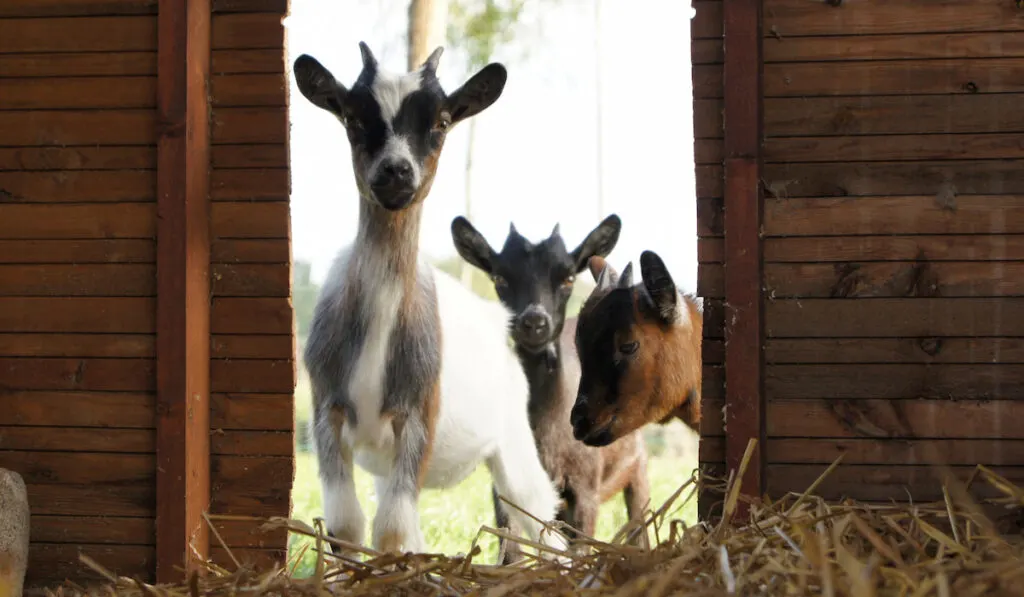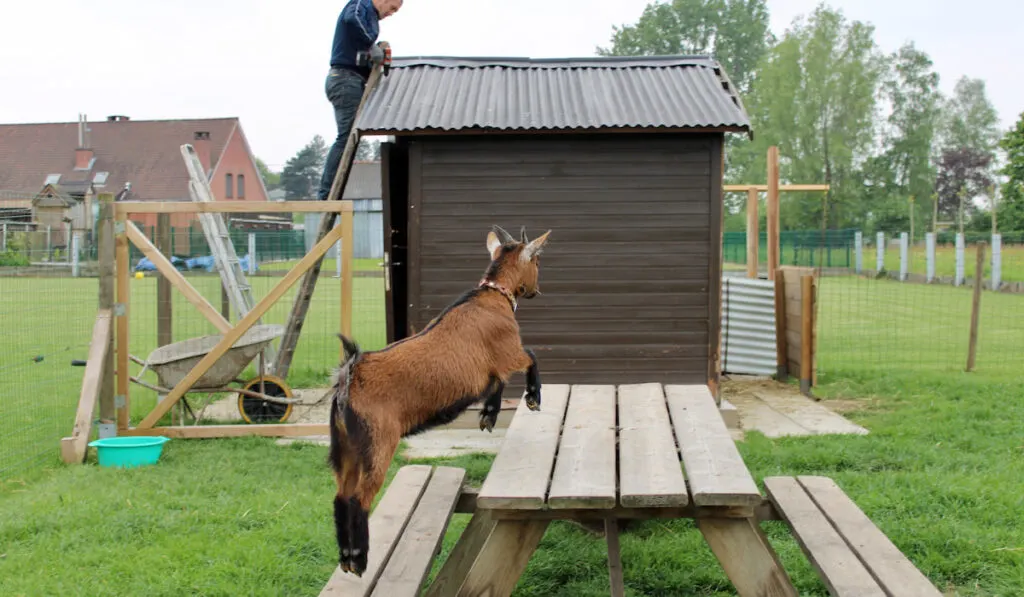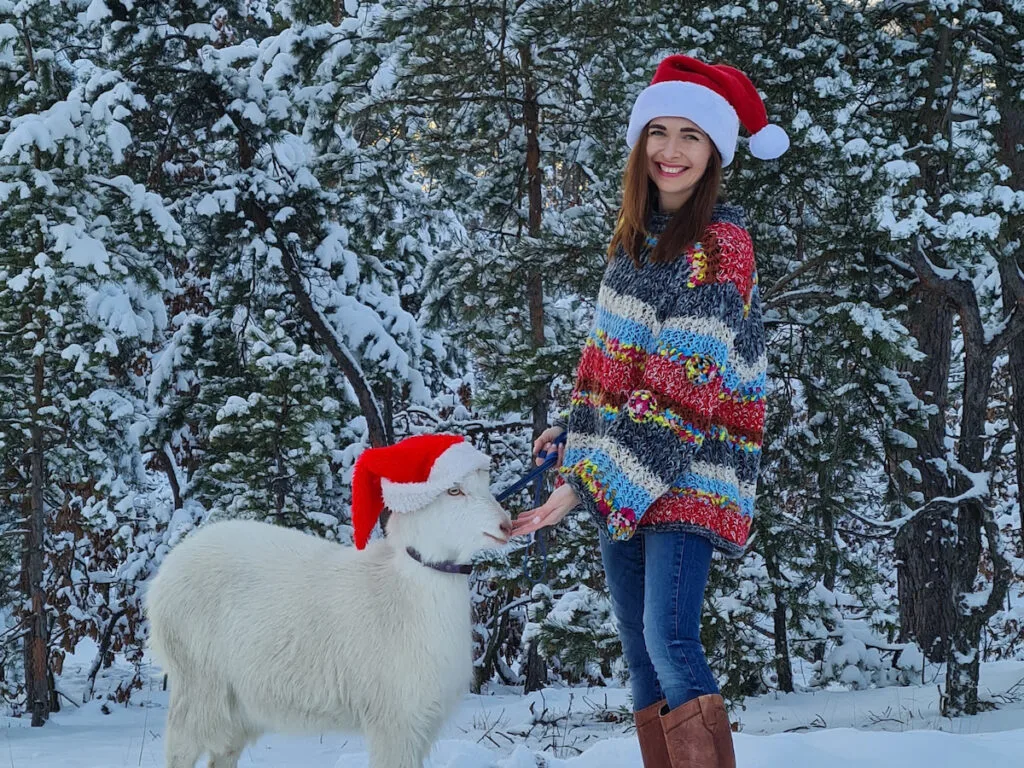As winter approaches, you may start to get concerned about how to keep your goats warm and comfortable. It is rational to feel this way.
Although goats are cold-hardy animals, they still require that extra bit of care to ensure they remain warm and healthy when it snows.
So, how can you keep goats warm in the winter? A goat’s fur will provide warmth through certain temperatures.
However, below those temperatures, you can keep goats warm in winter by improving ventilation, providing proper hydration, exercising, and proper feeding.
Caring for goats in the winter can be challenging. But as a goat owner, you can help reduce their stress with proper management practices.
In the rest of this article, we offer a detailed guide to help you keep your goats warm in winter.

Table of Contents
What Temperature Can Goats Comfortably Live In?
Generally, goats can comfortably live in temperatures between 54- and 75-degrees Fahrenheit. This temperature range is tagged the thermoneutral zone for goats. In essence, within this range, goats can maintain their body temperature with minimal effort.
How Coat Type/Texture Affects Cold Resistance in Goats
While most goats can comfortably thrive in temperatures between 54- and 75-degrees Fahrenheit, some can tolerate even lower temperature ranges. This ability to withstand lower temperatures partly depends on the coat of the goat.
The two most common types of coats in goats are mohair and cashmere. The texture of cashmere is fine.
But on the other hand, that of mohair is fuzzy and thicker than cashmere. Both types of coats are generally light and insulating but cashmere appears to offer more warmth than mohair wool.
It is estimated that the insulating capacity of cashmere is about 3-8 times that of wool. But that of mohair is about the same as that of wool.
While mohair is typically found only on Angora goats, most other breeds can grow cashmere coats. Goats that produce cashmere grow it as an undercoat.
Typically, this undercoat reaches its maximum length by winter. Then it starts to shed in early spring.
Although many goat breeds grow cashmere fiber, they do so to varying degrees of thickness. And since the resistance to cold depends on the density of the coat, some can tolerate colder temperatures better than others.
It is estimated that goats with about 2.5 inches of cashmere can remain unfazed in temperatures as low as 28 degrees Fahrenheit. So those with a healthy cashmere winter coat would do fine in 32 degrees Fahrenheit.
As expected, those with shorter lengths of cashmere coats may not do so well at temperatures as low as 32 degrees Fahrenheit.
Mohair is typically sheared from Angora goats before fall and in early spring. But since they grow mohair at a rate of 0.75-1 inch per month, the coat usually becomes thick enough before winter.
So, by winter, Angora goats can have up to 2-3 inches of mohair. This should be enough to insulate them in the same way as cashmere.
How Cold is Too Cold?
Generally, any temperature below 20 degrees Fahrenheit is too cold for goats. However, if it is windy, even 40 degrees Fahrenheit would be too chilly for them.

Best Bedding for Goats in Winter
The best bedding to help your goats to stay warm and dry in the winter is straw. Bedding down your stalls and barns using the deep litter method will keep your goats warm and comfortable.
The deep litter method simply means putting a new layer of straw over the old one. With this method, you do not have to clean your barn or stall throughout the winter.
Besides, the deep litter method ensures the bedding builds up a thick layer providing a barrier between your goat and the cold ground.
To keep your goat shelter from smelling, you can add a fresh layer of bedding each week.
Do Goats Need an Insulated Shelter?
Goats do not necessarily need an insulated shelter for the winter. Adult goats grow a thick cashmere undercoat, which helps them maintain a balanced body temperature in the winter.
What goats need is a three-sided shelter with one side open. They do best with proper ventilation.
When erecting a three-sided shelter for goats, ensure the open section is against the direction of the wind. Before the winter approaches, inspect to ensure it is not drafty. If you notice any drafty area, make necessary repairs to block it.
Do They Need a Heater?
Goats do not require a heater in a barn. In fact, you should try to avoid using a heat lamp in the barn. What your goat needs to stay warm is a draft-free barn, other goats to snuggle with, and adequate feeding.
Although situations may arise where you will need a heat lamp, use it with extreme caution. Keep the heat lamp away from walls and bedding to avoid barn fires and ensure the electric cord is inaccessible to keep the goats from chewing it.

7 Other Tips for Keeping Goats Comfortable in Cold Weather
The following tips will help you keep your goats warm and comfortable during the winter:
Proper Hydration
Drinking enough water during the winter protects your goats against dehydration.
Goats will drink less water when the water is frozen. This is why you need to provide goats with fresh warm water at all times and ensure the water does not freeze.
To ensure their water does not get frozen, you can keep heated buckets or any other water heating device in your barn. However, if your barn does not have electricity, you can provide your goats with fresh water regularly throughout the day.
Remember, goats do not like stale water, so ensure you keep your water buckets clean.
Exercise Your Goats
Allowing your goats to go out for a few hours can be beneficial to their health even when the weather is cold.
But if it is snowing, windy, or too cold, letting them go out is not an option.
Exercising the goats creates excitement, allows the goats to interact, and most vitally creates heat. Having multiple feeding stations on your farm can encourage your goats to exercise. You can also provide things like climbing blocks, climbing platforms, and toys to help them exercise.
Avoid Overcrowding
Once it starts snowing and the weather becomes cold, goats tend to huddle together for warmth. While this helps the goat, it can cause the shelter to become overcrowded.
An overcrowded shelter may lead to injuries, stress, and respiratory diseases. It is essential to monitor and regulate these crowds to ensure the goats are safe.
To prevent smaller animals from getting injured, create separate spaces where young stock and small-sized goats can gather.
Feeding
For goats to stay warm in the winter, they need to have more roughage in their diet. Feeding on roughage like fodder, hay, grass, and silage will help the goat create heat from the inside out.
If you feed your goats only grains in the winter, they might freeze to death due to the lack of roughage breakdown in the rumen.
Since your goats do not leave the barn, they will be unable to forage. This makes feeding in the winter very essential.
Ensure you check their hay regularly and replenish their supply when it is low. If you have pregnant goats during the winter, ensure they get the nutrition they require at all times.
Ventilation
Proper ventilation of your barn in the winter can help keep your goats warm.
In the winter, cold air usually settles on the barn floor and mixes with the ammonia from the animal waste. Proper ventilation will help push out the cold, smelly air and push down the warm air from the barn ceiling.
Improper ventilation will leave your goats exposed to cold air and drafts. Drafts are harmful to goats and leave them vulnerable to pneumonia.
Support Your Goat’s Fur Growth

Goats tend to grow furry coats to keep them warm during the winter. Most goat breeds have two layers of fur, with their cashmere coats covered by long guard hairs.
In the winter, the cashmere acts as insulation for the goats while the long guard hairs up top protect the skin from dirt and water.
Certain mineral deficiencies in a goat result in poor fur growth. Providing your goats with minerals like copper and zinc will improve their fur growth.
Do Not Cover Your Goats
Covering your goats with covers or coats for long periods can hinder fur growth and eventually make your goats colder.
Using covers and coats for goats is fine for a short time. This is especially valid if the goat is ill, was sheared recently, or cannot maintain proper body temperature.
Using covers and coats too often can be detrimental to the goats. They can rub off the goat’s fur. Then over time, the goat will rely heavily on covering to maintain its body temperature.
Final Take
Although keeping goats warm and comfortable can be challenging in the winter, it is still possible with proper planning and management practices.
Your goats will survive the winter if you provide them with adequate water, feeding, and a draft-free shelter.
Resources:
- https://www.thehaymanager.com/goat-and-sheep-round-bale-hay-feeders/keeping-goats-warm-in-the-winter/
- https://thefreerangelife.com/care-for-goats-in-winter/
- https://www.canr.msu.edu/news/winter-management-tips-for-goats
- https://backyardgoats.iamcountryside.com
- https://www.lancasterfarming.com/farming/livestock/don-t-leave-sheep-and-goats-out-in-the-cold/article_05768ad8-9486-538d-ae9a-b6e779319d0d.html
- https://americangoatfederation.org/wp-content/uploads/2020/08/Heat-Stress-in-Animals.pdf
- https://tropicinsider.com/alpaca-cashmere-mohair/
- https://www.masterclass.com/articles/fabric-guide-what-is-mohair
- https://lucafaloni.com/blogs/news/all-you-need-to-know-about-cashmere-a-guide-for-the-connoisseur
- https://cashmeregoatassociation.org/post.php?pid=3
- https://thriftyhomesteader.com/goats-in-winter/
- http://sfp.ucdavis.edu/pubs/brochures/ANGORA
